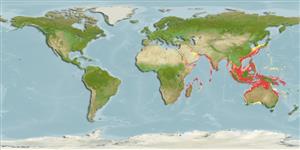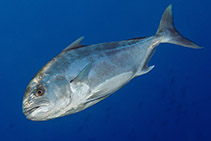Seriolina nigrofasciata (Rüppell, 1829)
Blackbanded trevally
Add your observation in Fish Watcher
| Native range | All suitable habitat | Point map | Year 2050 |

|
| This map was computer-generated and has not yet been reviewed. |
| Seriolina nigrofasciata AquaMaps Data sources: GBIF OBIS |
Upload your photos and videos
Pictures | Google imageSeriolina nigrofasciata
Picture by Greenfield, J.
Pictures | Google imageSeriolina nigrofasciata
Picture by Greenfield, J.
Thailand country information
Common names:
[No common name]
Occurrence: native
Salinity: marine
Abundance: | Ref:
Importance: minor commercial | Ref:
Aquaculture: | Ref:
Regulations: | Ref:
Uses: no uses
Comments: Known from Ko Sichang (Chon Buri), Gulf of Thailand, Songkhla and Andaman Sea (Ref. 37773). Also Ref. 3287.
National Checklist:
Country Information: https://www.cia.gov/library/publications/resources/the-world-factbook/geos/th.html
National Fisheries Authority:
Occurrences: Occurrences Point map
Main Ref: Monkolprasit, S., S. Sontirat, S. Vimollohakarn and T. Songsirikul, 1997
National Database:
Occurrence: native
Salinity: marine
Abundance: | Ref:
Importance: minor commercial | Ref:
Aquaculture: | Ref:
Regulations: | Ref:
Uses: no uses
Comments: Known from Ko Sichang (Chon Buri), Gulf of Thailand, Songkhla and Andaman Sea (Ref. 37773). Also Ref. 3287.
National Checklist:
Country Information: https://www.cia.gov/library/publications/resources/the-world-factbook/geos/th.html
National Fisheries Authority:
Occurrences: Occurrences Point map
Main Ref: Monkolprasit, S., S. Sontirat, S. Vimollohakarn and T. Songsirikul, 1997
National Database:
Common names from other countries
Classification / Names ชื่อสามัญ | ชื่อพ้อง | Catalog of Fishes(สกุล, ชนิด) | ITIS | CoL | WoRMS | Cloffa
> Carangiformes (Jacks) > Carangidae (Jacks and pompanos) > Naucratinae
Etymology: Seriolina: Latin word diminutive with the meaning of a large earthenware pot (Ref. 45335).
More on author: Rüppell.
Etymology: Seriolina: Latin word diminutive with the meaning of a large earthenware pot (Ref. 45335).
More on author: Rüppell.
Environment: milieu / climate zone / depth range / distribution range นิเวศวิทยา
เกี่ยวกับทะเล,น้ำเค็ม; กร่อย เกี่ยวกับหินโสโครก; ระดับความลึก 20 - 150 m (Ref. 30573). Tropical; 38°N - 35°S, 20°E - 163°E
การแพร่กระจาย ประเทศต่างๆ | พื้นที่จำแนกตาม FAO | ระบบนิเวศหลายระบบ | การปรากฏขึ้น,การเกิดขึ้น,พบ | Point map | การแนะนำ | Faunafri
Indo-West Pacific: Red Sea and East Africa to Japan, Australia and Solomon Island. Southeast Atlantic: southeast coast of South Africa (Ref. 3197).
ขนาด / น้ำหนัก / Age
Maturity: Lm ? range ? - ? cm
Max length : 77.5 cm TL เพศผู้/กระเทย; (Ref. 30504); common length : 50.0 cm TL เพศผู้/กระเทย; (Ref. 5450); น้ำหนักสูงสุดที่มีการรายงาน: 5.2 kg (Ref. 3287)
Max length : 77.5 cm TL เพศผู้/กระเทย; (Ref. 30504); common length : 50.0 cm TL เพศผู้/กระเทย; (Ref. 5450); น้ำหนักสูงสุดที่มีการรายงาน: 5.2 kg (Ref. 3287)
Short description เครื่องมือที่ใช้ในการแยกชนิดสัตว์,สิ่งมีชีวิตออกจากกัน | สัณฐานวิทยา | ความยาวต่างๆ
เงี่ยงครีบหลัง (รวม) : 8 - 9; ก้านครีบอ่อนที่หาง (รวม) : 30 - 37; เงี่ยงครีบก้น: 2; ก้านครีบอ่อนที่ก้น: 15 - 18. Color bluish grey to black dorsally, white to dusky below; 5-7 dark oblique bands or blotches on young disappear with age. Posterior spines of dorsal fin minute or embedded in large adults; first anal spine usually embedded. Gill rakers are mostly rudiments. Grooves of caudal peduncle present dorsally and ventrally. Maxilla reaching below rear margin of the eyes.
Mainly in offshore reefs on the continental shelf (Ref. 30573, 48635), on rocky bottoms (Ref. 11230). Non-schooling. Juveniles under weed rafts and adults are sometimes seen with the large planktivores such as whale sharks (Ref. 48635). Adults feed on demersal fishes, cephalopods, and shrimp (Ref. 11441). Excellent food fish (Ref. 3197); marketed fresh and dried salted (Ref. 3287).
Life cycle and mating behavior วัยเจริญพันธุ์ | การสืบพันธุ์ | การวางไข่ | เซลสืบพันธ์ของเพศเมีย(ไข่) | ความดกของไข่ | ตัวอ่อน
Main reference
Upload your references | อ้างอิง | ผู้ประสานงาน : Smith-Vaniz, William F. | ผู้ร่วมมือ
Paxton, J.R., D.F. Hoese, G.R. Allen and J.E. Hanley, 1989. Pisces. Petromyzontidae to Carangidae. Zoological Catalogue of Australia, Vol. 7. Australian Government Publishing Service, Canberra, 665 p. (Ref. 7300)
IUCN Red List Status (Ref. 130435: Version 2024-2)
Least Concern (LC) ; Date assessed: 09 March 2015
Threat to humans
Harmless
Human uses
การประมง: มีการค้าเพียงเล็กน้อย; การตกปลาเป็นกีฬา: ใช่
FAO(การประมง: การผลิต; publication : search) | FishSource | ทะเลรอบๆเรา
ข้อมูลเพิ่มเติม
Population dynamics
Growth parameters
Max. ages / sizes
Length-weight rel.
Length-length rel.
Length-frequencies
Mass conversion
การทดแทนที่
อุดมสมบรูณ์
Growth parameters
Max. ages / sizes
Length-weight rel.
Length-length rel.
Length-frequencies
Mass conversion
การทดแทนที่
อุดมสมบรูณ์
Life cycle
การสืบพันธุ์
วัยเจริญพันธุ์
ความดกของไข่
การวางไข่
Spawning aggregations
เซลสืบพันธ์ของเพศเมีย(ไข่)
Egg development
ตัวอ่อน
พลวัตของสัตว์น้ำวัยอ่อน
การสืบพันธุ์
วัยเจริญพันธุ์
ความดกของไข่
การวางไข่
Spawning aggregations
เซลสืบพันธ์ของเพศเมีย(ไข่)
Egg development
ตัวอ่อน
พลวัตของสัตว์น้ำวัยอ่อน
Distribution
ประเทศต่างๆ
พื้นที่จำแนกตาม FAO
ระบบนิเวศหลายระบบ
การปรากฏขึ้น,การเกิดขึ้น,พบ
การแนะนำ
BRUVS - Videos
ประเทศต่างๆ
พื้นที่จำแนกตาม FAO
ระบบนิเวศหลายระบบ
การปรากฏขึ้น,การเกิดขึ้น,พบ
การแนะนำ
BRUVS - Videos
Physiology
Body composition
Nutrients
การใช้ออกซิเจน
รูปแบบการว่ายน้ำ
ระดับความเร็วในการว่ายน้ำ
Visual pigments
Fish sound
Diseases & Parasites
Toxicity (LC50s)
Body composition
Nutrients
การใช้ออกซิเจน
รูปแบบการว่ายน้ำ
ระดับความเร็วในการว่ายน้ำ
Visual pigments
Fish sound
Diseases & Parasites
Toxicity (LC50s)
Human related
Aquaculture systems
ประวัติการเพาะเลี้ยงสัตว์น้ำ
สายพันธุ์
Ciguatera cases
Stamps, coins, misc.
Aquaculture systems
ประวัติการเพาะเลี้ยงสัตว์น้ำ
สายพันธุ์
Ciguatera cases
Stamps, coins, misc.
เครื่องมือ
Bio-Quiz | E-book | คู่มือภาคสนาม | เครื่องมือที่ใช้ในการแยกชนิดสัตว์,สิ่งมีชีวิตออกจากกัน | ผู้มีความชำนาญในเรื่องความถี่ของความยาว | เครื่องมือในการศึกษาชีวประวัติ | ตำแหน่งบนแผนที่ | Classification Tree
| Catch-MSY |
Special reports
Download XML
แหล่งที่มาจากอินเตอร์เน็ต
Aquatic Commons | BHL | Cloffa | BOLDSystems | Websites from users | Check FishWatcher | CISTI | Catalog of Fishes(สกุล, ชนิด) | DiscoverLife | ECOTOX | Faunafri | Fishtrace | GenBank(genome, nucleotide) | GloBI | GOBASE | | Google Books | Google Scholar | Google | IGFA World Record | MitoFish | ฐานข้อมูลแห่งชาติ | Otolith Atlas of Taiwan Fishes | PubMed | Reef Life Survey | Scirus | SeaLifeBase | แผนภูมิชีวิตแบบต้นไม้ | Wikipedia(Go, ค้นหา) | World Records Freshwater Fishing | บันทึกทางด้านสัตววิทยา
Estimates based on models
Preferred temperature (Ref. 115969): 21.9 - 28.3, mean 27 (based on 911 cells).
Phylogenetic diversity index (Ref. 82804): PD50 = 1.0000 [Uniqueness, from 0.5 = low to 2.0 = high].
Bayesian length-weight: a=0.02344 (0.01170 - 0.04697), b=2.93 (2.75 - 3.11), in cm Total Length, based on LWR estimates for this species & (Sub)family-body (Ref. 93245).
ระดับชั้นอาหาร (Ref. 69278): 4.2 ±0.57 se; based on food items.
ความสามารถในการกลับคืนสู่ปกติ (Ref. 120179): ขนาดกลาง, เวลาต่ำสุดที่จะทำให้ประชากรเพิ่มขึ้นเป็น 2 เท่าใช้เวลา 1.4 - 4.4 ปี (Assuming tm=2-4).
Fishing Vulnerability (Ref. 59153): Moderate to high vulnerability (51 of 100).
Climate Vulnerability (Ref. 125649): High vulnerability (61 of 100).




